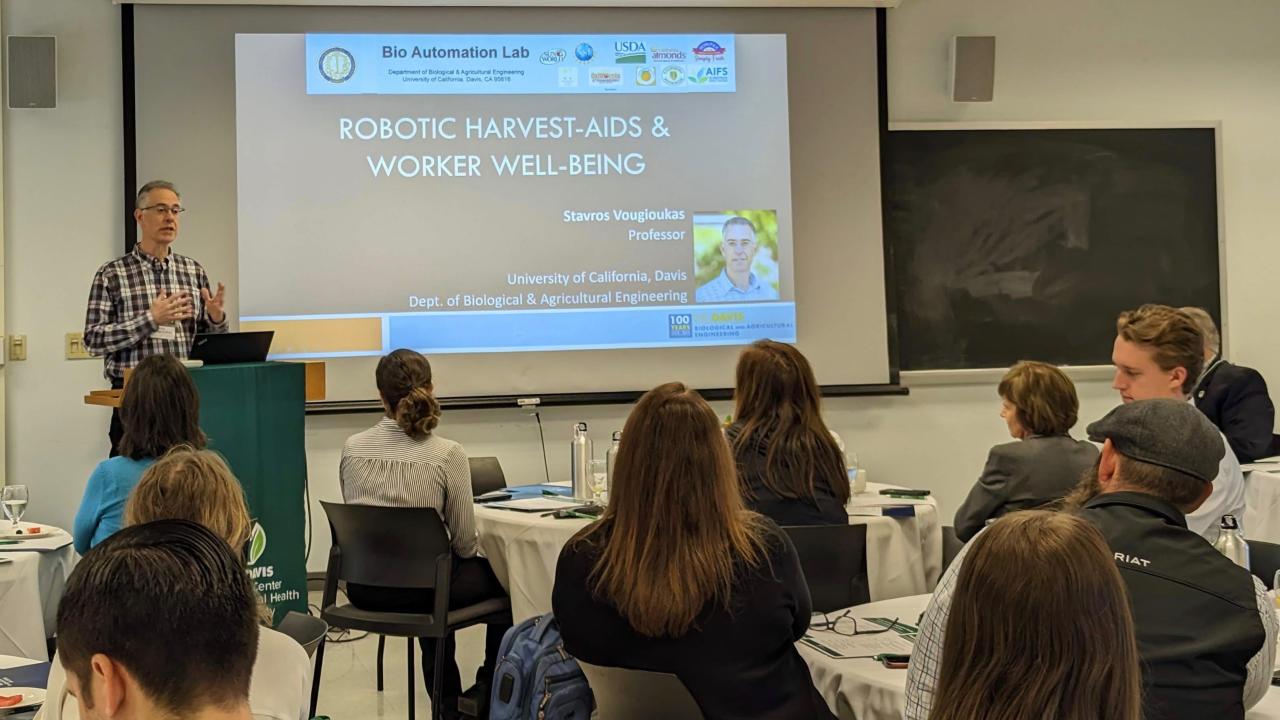
How Do We Balance Safety and New Technology?
This article summarizes the Emerging Technology in Agriculture: Keeping Health and Safety at the Forefront workshop, which was hosted by the UC Davis Western Center for Agricultural Health and Safety (WCHAS) on Thursday, May 11, 2023. WCAHS organized the workshop in response to the increased interest in agricultural technology and the need to ensure the safety of farmworkers coming in contact with technologies that may pose new hazards.
About the Event
The Emerging Technology Workshop convened over 40 participants from various fields including researchers, farmworker advocates, government, and industry. The overall aim of the workshop was to foster conversations on new agricultural technologies and farmworkers’ safety and health.
"Robotics and new technologies are changing farms and the nature of farmworkers' tasks. As we welcome innovation, let's ensure our progress does not unintentionally jeopardize health and safety."—Farzaneh Khorsandi, University of California, Davis
Event Overview
To meet its goals of increasing communication and networks, the event included a series of short talks followed by round table discussions and a full group summary session.
The short talks included an overview by Salah Issa, Assistant Professor, The Grainger College of Engineering at the University of Illinois. Dr. Issa provided an overview of currently available emerging technologies in agriculture, such as robotics, drones, and autonomous machinery, and discussed how these technologies may impact farmworker health and safety. After Dr. Issa’s broad introduction, speakers provided their perspectives on emerging technology. The six speakers included:
- Stavros Vougioukas, University of California, Davis, described how robotic harvest-aids can increase worker wellbeing and how semi-autonomous equipment can be a valuable middle ground.
- Pauline Canteneur, FarmWise, discussed the benefits of agricultural technology in that difficult work can be automated and each task can be precisely completed.
- Jake Winters, Monarch Tractor, presented on their tractor technology that incorporates the option of autonomous driving, data collection, and electric vehicle charging.
- Emily Bryson, California Department of Pesticide Regulation, discussed the capabilities of emerging equipment, liability, and the applicability of current regulations.
- Yancy Yap, Cal/OSHA, gave a background of current and historical regulations related to autonomous and semi-autonomous agricultural technology.
- Anne Katten, California Rural Legal Assistance Foundation, described concerns related to farmworker health and safety when autonomous and semi-autonomous agricultural technology are deployed in the field.

Two roundtable discussions followed the presentations. Roundtable discussions mixed participants from different fields to promote new networks and conversations. Participants discussed data that are available to assess the safety of emerging equipment and technologies for workers, as well as noted that datasets are limited. Participants also highlighted the importance of establishing a baseline of data with information, such as human and non-human operators, close calls, and incidents, to better inform regulations.
“The different views shared in the roundtable discussions certainly opened my eyes about how I look at typical safety and ergonomics issues related to human–machine interaction in agricultural settings. A paradigm shift may be needed to address safety and health implications of autonomous and semi-autonomous machines in agriculture.”—Fadi Fathallah, University of California, Davis
A second roundtable discussion focused on the factors that may increase or decrease the likelihood of injury and which workers may be most at risk. Of note was concern that safety features can be turned off or bypassed to make work faster, which could lead to significant safety hazards. Therefore, it was concluded that more engineering controls and trainings should be used to limit the temptation to override safety features. There were also concerns related to whether autonomous technology would react as quickly as a human to potential safety hazards.
Additional discussions continued around the economic and workforce implications of emerging technology, which may affect existing farmworker jobs by increasing the pace of work, taking away control from farmworkers, and decreasing work available, especially to those already trained on non-autonomous machinery. Alternately, it may be possible to use technology to create paths for higher paying jobs in the agricultural industry or to attract people to want to become farmworkers, especially if an educational route exists.
What Role Can WCAHS Play?
Participants who attended the Emerging Technologies Workshop provided valuable feedback on the roles WCAHS can play in emerging agricultural technology. Specifically:
- WCAHS can continue to act as a convener of different agricultural entities to ensure people from multiple sectors work together towards farmworker safety related to emerging technologies.
- WCAHS should continue to act as an educator by sharing stories about more desirable jobs that might come from technology advancement as well as create targeted educational materials related to emerging technologies.
- WCAHS will act as a training expert by providing guidance on the development of agricultural technology-based and culturally appropriate safety training programs developed by the center or others.
- WCAHS can be a mediator between people of differing roles in agriculture by anonymizing data to share with regulators and other parties.

Next Steps
The Emerging Technologies Workshop is just the beginning for advancing the safety of new agricultural technologies that farmworkers may come into contact with. Attendees had the following suggestions to keep the conversation going:
- Follow-up workshops;
- Working groups consisting of people from different sectors of agriculture;
- Call for research proposals related to this emerging issue.
Resources
- Watch Salah Issa's talk from the Seminar Series on YouTube.
- Watch Emily Bryson's talk from the Seminar Series on YouTube.
- Download the agenda from the workshop here.
